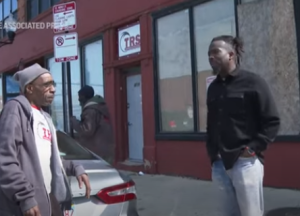In recent times, Chicago has been dealing with an increasing influx of migrants, many of whom are being transported to major cities led by Democratic leaders, including those with African-American mayors. This situation is creating tension within underserved Black communities, where long-standing residents feel overlooked in favor of the newcomers. These areas, already grappling with systemic issues like homelessness, violent crime, and a lack of essential services, now face the added challenge of absorbing thousands of new arrivals.
Local residents express frustration over what they see as an unfair distribution of resources. Black residents have long struggled with the absence of basic services in their neighborhoods. Banks, grocery stores, and quality educational institutions have been stripped away, leaving the community with limited access to critical infrastructure. Now, as funding is being allocated to assist the incoming migrant population, many in these underserved Black communities feel forgotten. The influx of migrants has exacerbated existing tensions, as residents question why resources are being directed toward newcomers while their own needs remain unmet.

Rising Animosity Amid Unmet Needs
The growing presence of migrants in historically underserved Black neighborhoods has led to a noticeable increase in animosity between local citizens and the new arrivals. Residents argue that their calls for improved local amenities, such as parks and jobs, are being ignored. They emphasize that their demands for better living conditions are not meant to exclude migrants but rather reflect the dire state of their own communities. When Black residents advocate for better infrastructure, jobs, and services, it should not be interpreted as a rejection of the needs of migrants. Instead, they argue that both groups are deserving of support, and their respective struggles should not be conflated.
Historical Context of Racism and Migration
The root causes of migration and the displacement of both Black and Brown populations are deeply embedded in systemic racism. Historically, African-Americans fled the Jim Crow South in search of better opportunities and an escape from the brutal realities of segregation and discrimination. Similarly, many migrants arriving in Chicago today are fleeing violence, poverty, and instability in their home countries, hoping to secure a better future for themselves and their families. Both groups share a common history of displacement due to systemic inequality and discrimination.
As one local activist pointed out, the driving force behind migration—both for African-Americans historically and for migrants today—is the search for living wages, stability, and safety. However, achieving these goals should not come at the expense of dividing communities. The solution to ensuring enough resources for everyone lies in building racial solidarity, not fostering competition between Black residents and new migrants. Both groups must work together to demand equal treatment and resources from the city.
The Role of Chicago as a Sanctuary City
Chicago has long prided itself on being a sanctuary city, a place where migrants can find refuge and build new lives. However, many residents feel that the city’s sanctuary status is not fully realized, particularly for its African-American population. While the city has taken steps to provide shelter and services to migrants, there are times when both Black residents and migrants themselves feel as though the sanctuary has turned into a “hell hole.” The inadequate living conditions in shelters and the limited access to essential services leave both groups struggling to survive in a city that promises more than it delivers.
Black residents of Chicago argue that their historical experience of oppression, disenfranchisement, and marginalization in the United States gives them a unique understanding of the plight of migrants. They know what it feels like to be left out, looked over, and ignored by the government, medical systems, and the economy. Because of this shared experience, they believe that African-Americans are in a unique position to help guide migrants through the challenges they face. Having overcome many of the same obstacles themselves, they see an opportunity to extend solidarity to those who are just beginning their journey.
Building a Path Forward Through Solidarity
The way forward for both Black residents and the migrant population lies in racial solidarity and collective action. Rather than viewing each other as competitors for limited resources, both groups can unite in their shared struggle for justice and equity. The challenges faced by both communities stem from systemic failures that have left them marginalized and underserved. By coming together, they can demand the resources and support they both need to thrive.
In conclusion
While the influx of migrants has created tension in Chicago’s underserved Black communities, the solution is not to divide, but to unite. Both groups share a common history of displacement and oppression, and they have much to learn from each other’s experiences. Only through solidarity and collective action can they achieve the justice and equity they both deserve. Chicago’s status as a sanctuary city must extend to all its residents, ensuring that everyone has access to the resources they need to build a better future.


